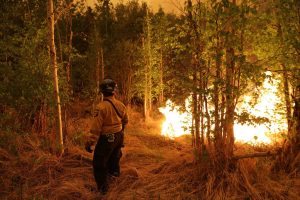Wildfire cleanup tips

Wildland firefighters will be safer on the job because of technology, says Forestry and Parks Minister Todd Loewen. Photo courtesy Alberta Ministry of Forestry and Parks
Picture the scenario where you must suddenly abandon all your responsibilities, gather your children, and evacuate your residence. This fear is shared by 57 per cent of Albertan residents, as revealed in a recent survey conducted by First Onsite Property Restoration.
Edmontonian Curtis Azevedo has seen much devastation from wildfires, floods and other disasters in his role as Quality Assurance Manager for First Onsite. He can relate how wildfires continue to grow more destructive each year, dealing with wildfire smoke and air quality, and insurance concerns for Canadians dealing with wildfires and disasters.
Curtis can discuss how wildfire smoke can travel far, and still release particulate matter and pollutants into the air, exacerbating respiratory conditions such as asthma, bronchitis, and COPD.
If this is of interest, I’d be happy to arrange an interview.
Below are some wildfire smoke tips from Curtis and First Onsite Property Restoration. You are more than welcome to use.
Smoke Cleaning Tips
- Smoke contamination can travel to areas of property and/or belongings that may not be visible to the untrained eye; hire a professional with specialized expertise in smoke cleaning to complete a proper assessment.
- If you do clean, remember that the environment may not be safe. Always protect yourself before beginning to clean fire residue: use a disposable dust mask or respirator, gloves and long sleeves or disposable coveralls.
- Smoke is attracted to the coldest areas of a building. These will be the areas that suffer the most damage.
- Swipe windows with a clean white tissue to determine potential contamination
- Light Brown – Brown dust: typical household dust
- Grey – Black dust: indicates contamination is present and area should be handled professionally to ensure safety
- Do not turn on any electronics as the soot will contaminate the inside of the unit. Electronics and appliances that have been affected by soot should always be inspected by a professional.
- Dispose of open or exposed food to avoid possible ingestion of toxic carcinogens.
- Keep doors and windows closed as much as possible to prevent smoke from entering your home and/or business.
- Consider sealing windows and door frames with tape to prevent smoke from entering your home or business if you are in close proximity to an active fire.
- Use an air purifier to help remove particulates from the air.
- Change furnace filters often – every few days or weekly depending on severity of smoke and air quality.
- Call your insurance company to understand what is specifically covered under your policy.
